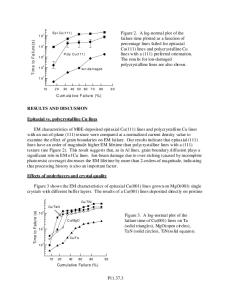Electroplasticity and Electromigration
- PDF / 1,694,540 Bytes
- 6 Pages / 414.72 x 648 pts Page_size
- 52 Downloads / 394 Views
moving electrons at the dislocation core. The motive force exerted by moving electrons on a (rela-
tively) stationary dislocation is analogous to the drag force exerted on moving dislocations by stationary (on average) electrons. Electron-dislocation drag effects are most notable as abrupt changes in the plastic deformation behavior of superconducting metals at the superconducting transition temperature and have been well documented. The motive effects of an electric current on dislocations have also been widely reported and the resulting deformation is referred to as electroplasticity. A review of these effects can be found in [1]. In a typical experiment, a sample is pulled in tension at a constant rate while pulses of electric current are passed through it. A drop in the measured stress is associated with each current pulse which, when the reversible effects of the current are removed, is attributed to plastic displacement induced by the current. Electroplastic effects have been reported for many metals, including aluminum. Varma and Cornwell [2] created current pulses by discharging a bank of capacitors across their samples and reported stress drops of 8% for polycrystalline and 50% for single crystal aluminum at maximum current densities of 3.7 x l04 on the order of 0.5 x and 2.5 x 104 A/cm 2 , respectively. Sprecher et al. [3] reported plastic strains 10-4 resulting from individual 60 lts rectangular pulses of 6 x 105 A/cm 2 in similar experiments in aluminum polycrystals. This electroplastic deformation was observed to increase hyperbolically with increasing current density and to decrease with increasing strain and strain rate. Livesay et al. [4] tested aluminum and A1Cu thin film samples (1 ltm thick and 2 mm wide) in tension with the concurrent application of 38 ms rectangular current pulses. They observed current-induced plastic deformation beginning at 5 x 104 A/cm2 which increased with increasing current density. Another way in which an electric current can cause a dislocation to move occurs when the dislocation line is oriented parallel to the current direction and the kinetic energy transfer acts to propel metal ions along the dislocation core. This type of electron-driven pipe diffusion process has recently been considered by Suo [5], who showed that, at least in theory, dislocations can be made 483 Mat. Res. Soc. Symp. Proc. Vol. 356 ©1995 Materials Research Society
to move and multiply in this way under current densities which are common in accelerated electromigration experiments. Simple examples include vacancy and interstitial loops, which could move without changing shape due to the diffusion of atoms from the up- to the down-wind side of the loop, and vacancy and interstitial threads anchored at grain boundaries which could grow into the adjacent grains and "blow out" dislocation loops by a similar process. Suo suggested that dislocation densities could become so large by this method as to make pipe diffusion a significant mechanism in electromigration. We know of no direct experimental ob
Data Loading...











